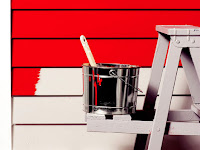 |
| Choosing The Right Paint For Outdoor Surfaces Can Save Time & Money |
When it comes to choosing and applying paint, facility maintenance professionals should consider several factors before getting started on their next project. The surface, the environmental conditions that surround the surface, and the quality of paint are critical considerations to determine which paint will work best.
The primary consideration when choosing paint is the environmental conditions that it will exist in. Its ability to hold up against the elements will vary depending on the facility or surface location. Harsh environments that are subject to extreme changes in temperature or high levels of humidity require more durable paints and coatings. Durability shouldn’t be sacrificed if the surface is exposed to chemicals or severe weather.
 |
| Correctly Prime Surfaces To Avoid Cracking and Chipping |
Another consideration is the temperature during the time the paint is being applied. Some water-based paints and coatings won’t properly cure if applied in cold weather. In addition, different paint products react differently to various application methods, such as paint brushes, sprayers or rollers. For instance, fast drying paints work best when sprayed. Brushes and rollers take longer in general, and are accordingly the best method to use for paints that take longer to cure.
Surface prep is also an important consideration. Taking shortcuts here can cause even top quality paints and coatings to break down. Surfaces that are prepared properly enable the paint to adhere more completely, offering better coverage and greater resistance to cracking and chipping.
If the surface is metal and there are signs of corrosion or oxidation, it’s critical to remove the loose rust and peeling paint. Primer should then be applied to prevent rust from re-forming. Wood surfaces should also be primed before the paint is applied. Avoid taking shortcuts like applying coats that are too thin. Doing so can compromise the paint’s ability to protect against mildew, cracks and chips.
Surface prep is also an important consideration. Taking shortcuts here can cause even top quality paints and coatings to break down. Surfaces that are prepared properly enable the paint to adhere more completely, offering better coverage and greater resistance to cracking and chipping.
If the surface is metal and there are signs of corrosion or oxidation, it’s critical to remove the loose rust and peeling paint. Primer should then be applied to prevent rust from re-forming. Wood surfaces should also be primed before the paint is applied. Avoid taking shortcuts like applying coats that are too thin. Doing so can compromise the paint’s ability to protect against mildew, cracks and chips.
Facility maintenance professionals should always consider the quality of the paint to avoid the painting project from costing more in the long run. While quality paints typically cost more up front, they provide better coverage and last longer. Higher quality paints are able to withstand scrubbing and cleaning and have a more consistent brushstroke. Over time, reducing the need for surface repainting, which saves both time and money.
Facility Maintenance | Industrial Coatings | Harrison Contracting Company

No comments:
Post a Comment
Note: Only a member of this blog may post a comment.